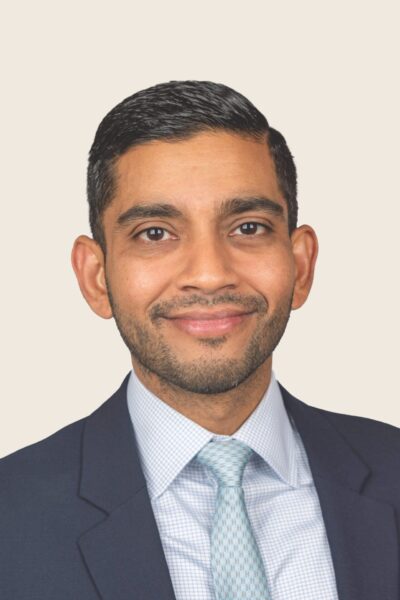Sean Anthony Eddy/Getty Images
Doctors + Machines: Evidence shows that when dermatologists combine forces with AI image-based technology, it can improve diagnostic accuracy.
Q: AI has infiltrated every industry, including the medical field. As the technology evolves, how will it help dermatologists (and patients) fight skin cancer?
Vishal Anil Patel, MD: AI makes us think of 2001: A Space Odyssey or The Terminator — and that man-against-machine sci-fi movie doom. But as dermatologists or patients, we shouldn’t be afraid of technology. We use our smartphones to tell us how to get from one place to another faster. It factors in traffic and allows us to choose the fastest route by car or public transportation. That’s all AI. In dermatology, AI can instantly analyze dermoscopic or clinical images of suspicious spots and help us determine the best route. There’s so much evidence that humans are not programmed to process information and images at the same high level that an algorithm can, so why not use technology to improve us?
In 2024, the FDA cleared DermaSensor, a light spectroscopy tool that uses AI to help detect skin cancer, including melanoma, squamous cell carcinoma (SCC) and basal cell carcinoma (BCC). This tool may address the shortage of dermatologists and long wait times in some areas by helping primary care providers identify those who need to be seen immediately for potential biopsy and expert care. But, just as with any new tool, we must be cautious not to overuse it, which can lead to overdiagnosis and overtreatment of early or innocuous lesions. This new technology could be a game-changer, but it’s too soon to tell. I would say I have cautious optimism.
Q: How will this tool, and ones like it, affect the number of biopsies dermatologists perform?
Skin cancer is a growing epidemic in the U.S., and the ability to accurately identify potential suspicious lesions without immediately reaching for the scalpel is invaluable. In the 1980s, ’90s and early 2000s, dermatologists were trained to think, “When in doubt, cut it out.” It was routine for patients to have numerous procedures, but is that what’s best for the patient? Does it make sense from an economic standpoint? These questions are at the core of the AI discussion. We biopsy a lot of benign things to find the malignant ones. Now, if we have 10 questionable spots and only biopsy two of them because the software algorithm says they have a high risk of skin cancer, we can watch the other ones and reassess later based on images.
Q: How can AI help with skin cancer post-diagnosis?
Gene expression profiling (GEP) testing is a type of AI that helps us determine if a biopsy is a malignant lesion, or if the risk of recurrence and metastasis is high and can help clinicians decide on the best course of treatment. The testing may also help decide if extra treatment, such as radiation, is needed in certain patients, or more frequent follow-up. In others, it may help de-escalate therapy. For example, do I need to radiate a large SCC in a 90-year-old who can’t get to radiation five days a week for four weeks when the GEP test says the tumor is low risk? It’s like telling someone that every cavity needs a root canal when you don’t necessarily need that. Not every skin cancer requires surgery or radiation; others may benefit from the addition of adjuvant immunotherapy. AI is making us more precise, and we’ll be better at assessing a patient’s risk with the different tools we have.
Q: What are the limitations of AI in dermatology?
The piece of AI that many people forget is that machine learning technology is meant to learn on itself, and then we must learn from both the good and bad information. It’s the mistakes that you make in the algorithm that help to teach you how to do it right. And it doesn’t have to be perfect because who is the stopgap? The expert: the dermatologist. So, if I use this tool, and the results don’t make sense, I’ll fall back on my clinical judgment that tells me this lesion is suspicious; I need a biopsy. It’s like the episode of The Office when Michael drives a car into a river because his GPS tells him to turn where there’s no road. Don’t turn! You shouldn’t follow the machine’s instructions if they don’t make sense.
Q: What do you say to dermatologists who fear AI will replace them?
You’re not going to get replaced. In the 1980s, airplane pilots thought robots would replace them. But now our planes are safer, faster and more efficient, and look how important pilots still are! The human brain has limitations, so to be the smartest dermatologist, you must use the tools you have. These AI tools are going to make us smarter — if they make sense for the patient. That’s why the clinical judgment of the dermatologist is key, and even more critical now. Ultimately, it will make us better dermatologists and more efficient, and, because we have a shortage of dermatologists, it could help address this problem as well.
Q: So how should dermatologists and patients approach AI?
AI has been rolled out quickly, even a little aggressively, and we’re not quite ready to widely adopt it. But I think we’ll be there in five years, so dermatologists should start thinking seriously about AI. Right now, we have many different products: handheld tools, including smart phones that can take high-quality photos, plus dermoscopy and confocal microscopy to look even deeper into the skin. There are new tools with light spectroscopy like DermaSensor. They all use similar software algorithms that process this various data, no different than how our brain processes the various input data. Evidence suggests that if we combine the technology with the skill of dermatologists, we can get to really high accuracy levels.
We should first approach the field of AI, understand its uses and its limitations, and then approach it as individual dermatologists. Ask the questions: “How will this impact the patient? Will it change the number of biopsies I do on a patient with biopsy fatigue? Is the gene expression profiling score going to change something I do for the patient, and if not, do I even need this information?” I think if we take this approach, incorporating it into the practice is going to be smoother.
These tools are going to help patients feel more assured and empowered, too. I’m excited about tools that patients can use to take pictures of things on their skin, monitor themselves and share that information with their doctor. There’s this expectation that when you see a dermatologist and they didn’t find anything, you’re good. But that’s not how medicine works; it’s a partnership. Dermatologists can’t be expected to get everything right in a 10-minute visit. These tools are going to help on both sides. — Interview by Julie Bain and Krista Bennett DeMaio

ABOUT THE EXPERT:
Vishal Anil Patel, MD, is director of cutaneous oncology, GW Cancer Center; director of dermatologic surgery, GW Department of Dermatology; and associate professor of dermatology & hematology/oncology, George Washington University School of Medicine & Health Sciences, Washington, D.C. Dr. Patel was a 2020 recipient of a research grant from The Skin Cancer Foundation.




